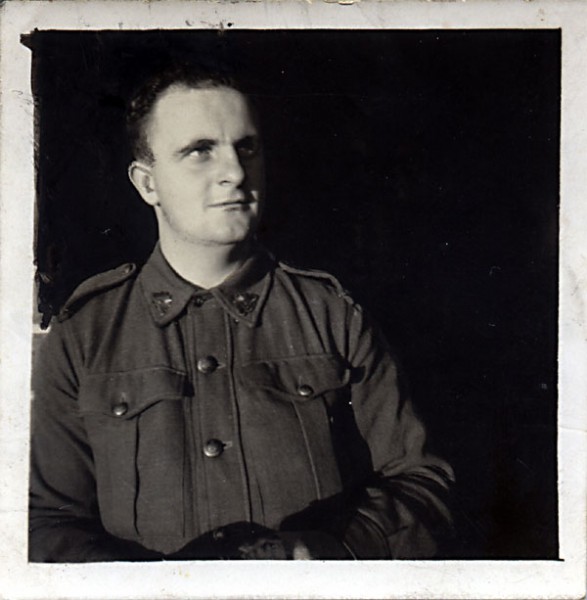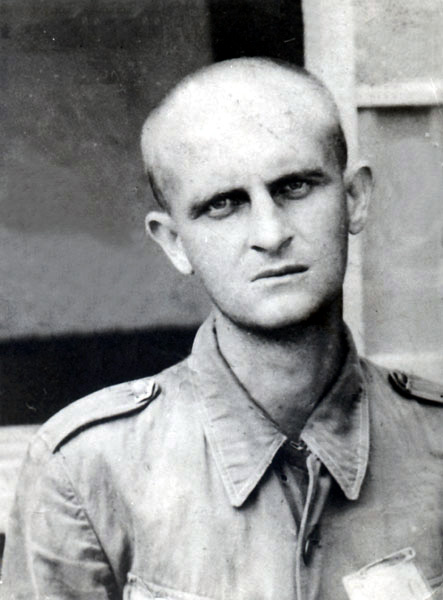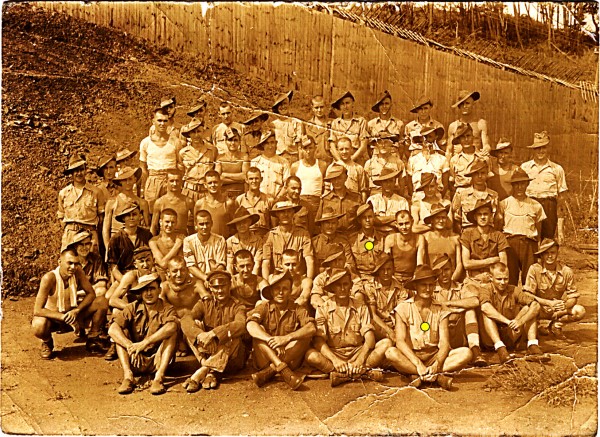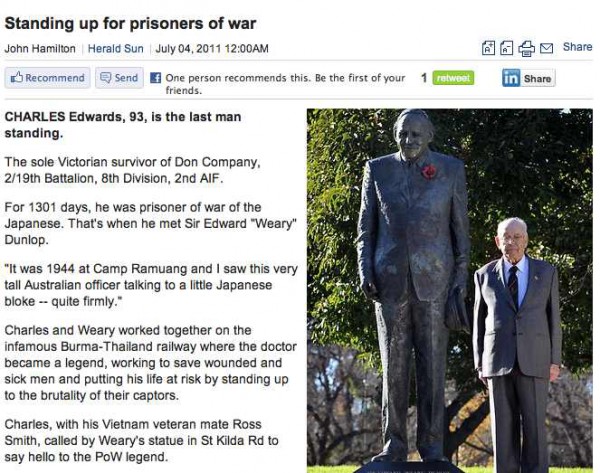News
Feb 15, 2012
Story of 2 POWs
by John • News • Tags: Charlie Edwards
Today, the 15th February, is the 70th anniversary of the Battle of Singapore on the 15th February, 1942, a significant and moving day in the history of Singapore. My father had been fighting with the 2/19th Battalion, AIF, in Malaya, just to the north of Singapore, near the River Muar, and he had already been captured by the Japanese by this time. I have been looking into the history of my father’s time in the army and had published a few letters in various publications.
Some time back I wrote an article about my father, Frank, and I mentioned that there were gaps in my knowledge about the experiences of my father as a POW as his force were moved around southeast Asia and Japan during his incarceration from January 1942 through to September 1945. I have created a web site about my father’s war time experiences.
Then, one day I received a moving letter from Charles Edwards, one of my father’s friends in the 2/19th battalion, 8th Division, AIF. He was replying to the article I had written. Charlie had been with my father for almost every single day of their imprisonment. I had mentioned Charlie in my article. Charlie’s letter included detailed maps and photographs. I shall publish those in the near future. This is Charlie’s letter…
[This post has also been published on my primary web site]Dear John,
Thank you for making reference to my story in the “Grim Glory” and conditions in Pudu Gaol. Yes, I am the same Charles Edwards and I can tell you a little about your father NX 43393 Frank X. Larkin.
Frank Larkin, newly recruited soldier in the AIF
I guess you are aware of the circumstances of the Battle of Muar. On the 16th December 1941, the 2/19th Battalion was shifted from Jemaluang [in Malaya] where it was reserve battalion guarding an expected landing on the beaches at Mersing, to assist the 2/29 battalion who were being hard pressed by the Japanese just south of Muar on the west coast.
The Japanese, on their thrust towards Singapore, had been ambushed with heavy casualties on a bridge at Gemas, by the 2/30th battalion under Colonel “Blackjack” Galleghan. They abandoned this thrust, and being masters of the encircling movement, turned south and crossed the Muar River at Muar, and continued their thrust along the south road.
Here they met the 2/29th battalion, and inflicting heavy casualties on them the 2/19th battalion were shifted overnight to assist them. The Japs who with superiority in the air, and with tanks, we had neither, gradually pushed us about 16 miles to a kampong Parit Sulong on the banks of the Sungei Simpang Kiri where on the 21st January 1942 we found ourselves surrounded, again the Japs had encircled around and held the bridge.
H.Q. was on the east side of the road, and I was among ten men who were sent to fill a gap of a hundred yards in the perimeter defences. The following morning, the 22nd January, we came under heavy machine gun fire from a Jap tank. Of a group of about 30 men there were just eleven left alive.
It was then that we sent a man over to the east side to H.Q. and found it deserted. They had made their get-away in the night crossing the river. It was here that Frank would have assisted others to ford the river Simpang Kiri… Now I believe with a name change to Sungei Lenik.
It would have been after this that he was taken prisoner. I was taken prisoner on the 22nd January 1942 and three days later entered Pudu Gaol. I recall that over the next fortnight small groups drifted into the gaol. Frank, as I recall, came in with Captain Reg Newton and Sergeant Sam Cameron, “D” Company, Quarter Master Sergeant. They were all in a very distressed state about the end of the first week in February 1942.
About the middle of March, well after the Fall of Singapore, we were moved, the Australians first into the gaol proper, from the very crowded and insanitary area of the Womens’ prison. Here the boredom of a P.O.W.’s life went on, and most of the men stricken with diaorrhoea or dysentery as well as malaria, and all on very tiny rations.
After a while the men started to succumb to three other diseases and all were diet deficiency diseases. Beri-beri, extreme tinea, and “happy feet”. With beri-beri the ankles, testicles and face all swell up like footballs. I recall on my way back from the tong a fellow said “good day Charlie”. I looked at him and all I could see was three slits, his two eyes and mouth, even his nose had disappeared. He was unrecognisable.
Tinea started at the scrotum and continued in about a four inch strip down to the knees on the inside of the legs. The itch was unbearable, and if you scratched it, it only became worse. The only remedy we had was coconut oil, and when we applied this we could hardly stand it. “Happy Feet” was like having pins and needles in the feet only about ten thousand times worse than ordinary. Frank would have suffered at least two of these diseases.
Days ran into weeks and weeks into months. It must have been into May when we had a change of administration to a Naval camp Commandant who was much more lenient. We all said he have been round the world a little bit more and learnt to be a bit more compassionate. He introduced a canteen where we we were allowed to buy peanuts, bananas, and other fruit and tobacco. With these extra nutrients these diseases disappeared.
So life in Pudu went interminably on until about the first weeks in September, when rumours began to fly that we would be moving. So, on the 30th September, 1942, the Australians were moved by train to Singapore.
On our arrival in Changi it was almost like coming home. Everyone was well dressed and looking fit. In Pudu the Japs had given us nothing, we were in rags, some of the men were still eating out of hub caps and coconut shells.
And, yes Frank was absolutely correct in saying we were only in Changi three to four weeks when we were shifted to a camp in Havelock Road. As near as I can make out it would have been somewhere I have indicated with a small red dot. Then we were only there about a month when we were shifted across a path over a boggy area to River Valley Road camp. About where the large red dot is on the map. Here we remained until about the end of February 1943, when we were shifted back to Changi.
Here we got ready to go to Thailand, and again Frank is correct in saying we only had a short time in Changi, both times totalling only about six weeks.
From here we were prepared to go to Thailand, a train load of about 3500 men who were to become known as “D” Force. After a horror trip of five days in which we were crammed 30 men to a rice truck, and about 20 sacks of rice, which were to be our rations, we arrived in Bam Pong where we were broken up into butais ~ the Japanese name for battalions ~ and then designated alphabetically, and we were called “U” Battalion, or “U” Butai. A name which instantly became “You Beauties”.
John, I’ll leave out the horrors of life on the Thai-Burma railway, but if you need to know about it you could let me know, but it would be much the same as described in the “Grim Glory“.
After 455 days the railway was finished and those of Reg Newton’s “U” battalion who were still in good nick were called the “good looking boys” by the Japs and were sent again by train back to Singapore, where we were marched again to River Valley Road camp. After a few days there we were again marched to the Empire Dock and on 1st July 1944 boarded the “Byoki Maru” and on the 4th July set sail and after a 70 day voyage arrived in Moji, Japan (now known as Kita Kyushu) and then by coal barge to Ohama.
My father, Frank Larkin, photographed a day or so after he arrived in Ohama POW Camp, Japan
On arrival there were about 200 British men in the camp, and Reg Newton’s policy of whatever proportion of Australians were in the camp he insisted on the Australians have that proportion of the good jobs such as cooks etc. The camp had a small bakery so I became the camp baker with the already existing British man, but Frank was like most of the other men and became a miner. The coal was about two kilometres out under the seas, so being a miner was an unenviable job.
About six weeks before Christmas 1944 the Camp Commandant Shosa (Lieutenant) Kushimoto brought in two large pigs which were to be our Christmas treat. I don’t know by which process but Frank was made “buta otoko” or pig man. I was “pan otoko” or bread man. Frank’s job was to look after and feed these pigs. This was a weclome respite for Frank, from the drudgery of working down the mine every day. He had freedom to go and cut grass or anything that looked like feed for pigs.
Then he was told about Okita San, a lady who ran a hostel, located at the other end of the village about 800 metres away, for Koreans working in the mine (in Japanese San is Mr, Mrs or Miss).
There were three guard commanders, Nagashme San, Nagatomi San, and Kotakihara San, all were ex-service men with battle disabilities, and we had nicknames for two of them, Nagatomi walked with a limp so we named him “Hopalong” after the American movie hero Hopalong Cassidy. Kotakihara San wore a heavy leather wrist band, so he was “Leather Wrist”.
Okita San always had a bit of left overs from her tenants, and Frank went and picked up what I called pig swill, and carried it home for the two pigs in two wooden tubs with a bamboo pole across his shoulders like the Chinese. One day he asked me whether I would like to help him. I think the tubs were almost as heavy as the contents. So I readily agreed as I didn’t get out of camp much, but always under guard.
It so happened that Leather Wrist (Kotakihara San) was engaged to the daughter of Okita San. She was also known as Okita San (Miss San). As a result Leather Wrist was always our guard. As soon as we appeared in Okita’s kitchen Leather Wrist would disappear upstairs with young Okita. The first thing I noticed in the kitchen was a row of potatoes above the window. Frank said to me to make no comment about the potatoes, not to even see them. When it came time to go Leather Wrist would appear and while he was saying goodbye to his fiancee Okita would turn her back and throw the potatoes into the pig swill. Frank and I would now carry the buckets between the two of us making Frank’s jobs so much easier. When we arrived back at the camp Frank would smuggle the potatoes to me and I would bake them in their jackets in the oven. For a few weeks we had that little extra to eat. Christmas came and the pigs were slaughtered by Dick Fair who was a butcher. So ended our little outing to Okita San’s. Frank went reluctantly back to the mine after Christmas.
The picture* that you have had published was taken by a Japanese photographer after the surrender out to make a few yen for himself.
*This photograph was taken on or about August 21st, 1945. Charlie is in the second row, my father in front.
The area to the top right of the photograph shows the boundary fence. It was made of bamboo, with sharpened criss-cross bamboo along the top, live wires running between the criss-crosses. Also a strip one metre wide running the entire inner boundary with nothing in it. This was out-of-bounds, and if you ventured on to it this was regarded as an attempted escape and you would be fired on.
After the war Frank and I had a day out in Sydney, ending the day at his sister’s house who was married to a Jewish man. We stayed the night, having to share the same bed. After all we had slept much closer than this during our days as POWs. After this we both went our separate ways, and through the years I observed that Frank was a very generous donater to the 2/19th battalion magazine.
It must have been sometime in the 1970s my wife and I were traveling through Wollongong when we stopped for petrol. I asked the attendant if he could tell me where Frank Larkin had his business. He walked a few steps until it came into view and there up on the hill F.X. Larkin Pty. Ltd. in two metre high letters. When I walked into his office I noticed an array of his children all in their academic gowns, and I have no doubt you would have been there among them.
Frank told me that all the time he had been in business, I was the only 2/19th chap who had come to see him, even though he had so generously advertised in the 2/19th battalion magazine.
After this we exchanged Christmas cards for a number of years, right up until he had a stroke.
So John, thank you for taking me for a brief trip down memory lane of the events of your father, generous to a degree and upholder of his Christian faith, but to me a very good old mate, who I always called simply “F.X.” and he in turn called me “C.E.”
And I couldn’t agree more with him about his remarks about “Roaring Reg” Newton. My comments are “the greatest officer that ever pulled boots on”.
I hope that I have filled in a few gaps in your father’s POW life.
Yours very very sincerely,
Charles Edwards
Jul 4, 2011
Charlie Edwards article
by John • News • Tags: pow, Thailand
Charlie Edwards, a friend of my father during the Second World War and after, received a write-up in the Herald Sun today. The article focused upon Charlie’s meeting with Sir Edward “Weary” Dunlop while he has a POW on the Thai-Burma Railway as well as the forthcoming launch of an appeal to raise $200,000-00 for medical research via the Sir Edward Dunlop Medical Research Foundation. You can read the full article over at the Herald Sun.
Hat tip to Adele Brice and Adam Brice for the pointer to the article. Thank you!
Jun 13, 2011
New links added
These are the first links added to this dedicated Links page. Additional sites will be added as time passes. Links to relevant and worthy web sites will be added to the dedicated page. Each will be reviewed. If you would like to recommend a web site for the Links page please drop me a line via the contact form.
Australian Web Sites
| Australian War Memorial | This excellent resource features an amazing database and links to online exhibitions, family research assistance and countless other rich historical resources. |
| Australian prisoners of the Japanese | This page at the AWM provides an overview of Australian soldiers who were prisoners of the Japanese during the Second World War. This related table lists the dates when various prisoner-of-war forces left Changi, Singapore, and their destinations. |
| Stolen Years | This website, hosted by the Australian War Memorial, recounts the experiences of Australian prisoners of war during the First World War, Second World War and the Korean War. It is a well designed web site with personal accounts, maps and photographs. |
| Behind The Wire | This site is a component of the excellent web site Australia's War 1939-1945. |
| War for the Empire: Malaya and Singapore, Dec 1941 to Feb 1942 | This excellent online essay, War for the Empire: Malaya and Singapore, Dec 1941 to Feb 1942 by Dr Richard Reid provides a well written and superbly illustrated account of the conflict between Australia and Japan. |
| Prisoners Of War Of Japanese 1942-45 | This well researched web site created by Lt. Col. Peter Winstanley OAM RFD (Retired) JP features the stories, images, poetry, drawings and photographs of the prisoners of the Japanese, 1942 to 1945. |
| Australians At War | This excellent web site has hundreds of stories about Australian men and women who fought in the various wars last century... I have selected some of the stories that relate to the experiences of my father. |
| The Battle of Parit Sulong | This battle was the sight of the first large massacre of Australian troops by Japanese forces. It occurred on the west coast of Malaya on 22 January 1942. |
| The Battle in the Muar and Bakri Region of Johore state, Malaya, January 1942 | This is a concise yet informative account of the battle of the Muar. My father was cpatured during the course of that battle. |
| General information about Australian prisoners of the Japanese | More than 22,000 Australians became prisoners of war of the Japanese in south-east Asia. The majority of the Army prisoners were largely from the 8th Division captured at the fall of Singapore. My father was a member of the 8th Division. |
| Burma Thailand Railway Memorial Association Inc. | Burma Thailand Railway Memorial Association is an organisation run by volunteers, including surviving ex prisoners of war (POW) of the Japanese during World War II who worked on the Burma-Thailand railway. |
| Fifty Australians: Charles Anderson VC | This is the story of Lieutenant Colonel Charles Groves Wright Anderson. He was second in command of the 2/19th Battalion. |
| Elliot McMaster. A Prisoner of War on the Thai Burma Railway | This is a brilliant web site. Elliot McMaster clearly and concisely sets out his time from enlistment in the AIF and the 2/20th Battalion through to his wartime experiences in Malaya, his capture by the Japanese, time on the Thai-Burma railway, liberation and finally, his return home. Supported with excellent photographs, maps and a handy contents list. |
| 2/4th Machine Gun Battalion ~ Remembering The Fallen | During the Second World War a machine gun battalion was raised for each division of the Second AIF. Western Australia’s 2/4th Machine Gun Battalion was raised as one of the support units for the ill-fated 8th Division. Formed with men from WA, they assembled at Northam military camp, east of Perth, where they carried out their initial training. |
| Digger History | Digger History is an unofficial history of the Australian & New Zealand Armed Services. This comprehensive web site provides visitors with the opportunity to explore the military history of Australia and New Zealand together with information regarding the role played by indigenous recruits in our army. You can aslo explore information regarding badges, colurs, flags, weapons, food, medals, uniforms and even poetry. There is also an extensive set of valauble links to other web sites. |
| The Thailand-Burma Railway Centre | The Thailand-Burma Railway Centre is an interactive museum, information and research facility dedicated to presenting the history of the Thailand-Burma Railway. This ran 415 km from Ban Pong in Thailand to Thanbuyuzayat in Burma, and was built by the Imperial Japanese Army during the second World War using Allied prisoners of war and impressed Asian labourers. The Centre is fully air-conditioned and offers the visitor an educational and moving experience. The web site is most informative and well illustrated. It also includes a rich set of links and resources. |
| WWII Collections | This excellent web site was created by Susan Metros, an educational technologist based in the United States. She has created this wonderful resource about the experiences of her father, William Yenofsky, who had been a U.S. serviceman during World War Two. |
| Changi Museum | This is the official web site of the Changi Museum in Singapore. It features a map of the exhibitions and describes recent events at the museum. |
| Colours Behind Barbed Wire | This interactive and beautifully deisgned web site is hosted by the National Archives of Singapore. It looks at life in Changi Prison through the artwork of W.R. Haxworth. |
| 1942: Battlefield Singapore | This excellent web site looks at the fall of Sinagpore and the impact of the Japanese occupation upon the island. |
| Far Eastern Heroes | This web site beautifully sets out the stories of the men and women who were and still are the heroes of the war in the Pacific. They struggled through the years of hardship and internment to emerge as survivors and victors. This web site is part of the excellent Far Eastern POW community web site. A wonderful resource! |








